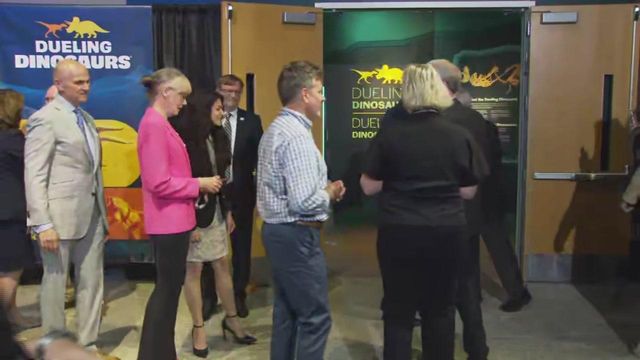Destination: Catching glimpses of the red wolf pups at the Museum of Life and Science

On Thursday, in the heat of mid-day, four red wolf pups scrambled in the grass and up a cliff in their enclosure at the Museum of Life and Science in Durham.
The exhibit has been a popular spot for visitors in the last couple of months as they try to get a glimpse of the little ones. And, now, as the pups become older and more mobile, those glimpses could be more frequent.
"They are out more," said Sherry Samuels, the museum's animal department director. But, she says patience is still required and suggests visitors think of themselves as wildlife biologists. "Most of the time, it's waiting and watching," she said. "Ninety percent waiting for 10 percent of those 'wow' moments."
The pups were born in late April to the museum's six-year-old red wolf. It was big news for the species. Once common across the southeast, red wolves now are critically endangered. Only about 200 exist in captivity; another 40 or so live in the wild, at last count. The museum's pups are among one of only five red wolf litters born in captivity in the United States this year, Samuels said.
They account for a full 2 percent of the captive red wolf population. "What a treat for the museum and for Durham," she said.
This week, the pups turn seven weeks old and, already, there have been big changes. First, two sad ones: Two of the original six pups have died. But the remaining four appear healthy and seem to be growing like weeds, according to their last regular checkup.
During their first month, the pups didn't move much, holed up in a den near the front of the exhibit where they were born. They still spend time inside the den, but can now be found out and about more often.
They are scheduled to get their first round of vaccines next week. And, already, they're losing their floppy puppy ears and darker puppy fur as they grow, but they remain absolutely adorable.
"What's not to love about a puppy?" Samuels said.
On Thursday, shortly after Samuels threw out a lunch of thawed rats to them, the crowd at the enclosure got lucky with plenty of those rare "wow" moments. All four of the pups emerged - two from the top of the enclosure's cliff and two from a den toward the front of the exhibit. Their parents came down from their perches, under the tall trees at the top of the enclosure's cliff, to grab the rats.
One pup got hold of a rat. Mom shared another rat with another pup, who then poked his nose at her mouth. So she stopped, opened her mouth and ... yes, regurgitated the food into the pup's mouth. (Dad, who is a very attentive parent and has spent the last few months ensuring both mom and babies have food, feeds the pups in the same way, too, Samuels tells me).
The crowd groaned a little bit as Samuels explained the scene between mom and pup.
"It seems gross to us, but that's natural," Samuels said. "I'm not excited about vomit - except here."
A ranger will be stationed at the enclosure all summer to answer questions about the wolves and track their movements to make it easier to point them out to visitors. Samuels says it's best to be quiet when watching red wolf pups do their thing. Loud noises can scare them back to their hiding spots. Signs also remind visitors to keep their voices down.
"People are excited," she said. "But you can be excited and still be quiet. We're stewards and we want to teach guests to be respectful of animals."
What's next for the pups is a lot of growing. Today, they weight about four pounds. By the end of the summer, they should weigh about 30 pounds. The museum also could find out what the future may hold for them in the next couple of months.
Samuels is a member of the Red Wolf Species Survival Plan management team, which leads a collaborative breeding and management program developed by the Association of Zoos & Aquariums to ensure the sustainability of endangered animal populations like red wolves. In late July, the group will meet to talk about the status of the species and possibly place the pups elsewhere.
"We do what is most helpful for the population," Samuels said.
Pups from the museum's previous two litters, born in the spring, were placed at other locations by the fall. But, Samuels said, there aren't many places with room for red wolves right now.
"I feel confident these guys are going to be here for the year," she said.
You can stay up to date on the wolves through the museum's Animal Keeper blog. It's free to see the pups with admission to the museum, which is $18 and $13 for kids ages 3 to 12.
Take a closer look at the pups in this video from the museum:
Go Ask Mom features places to take kids every Friday.









